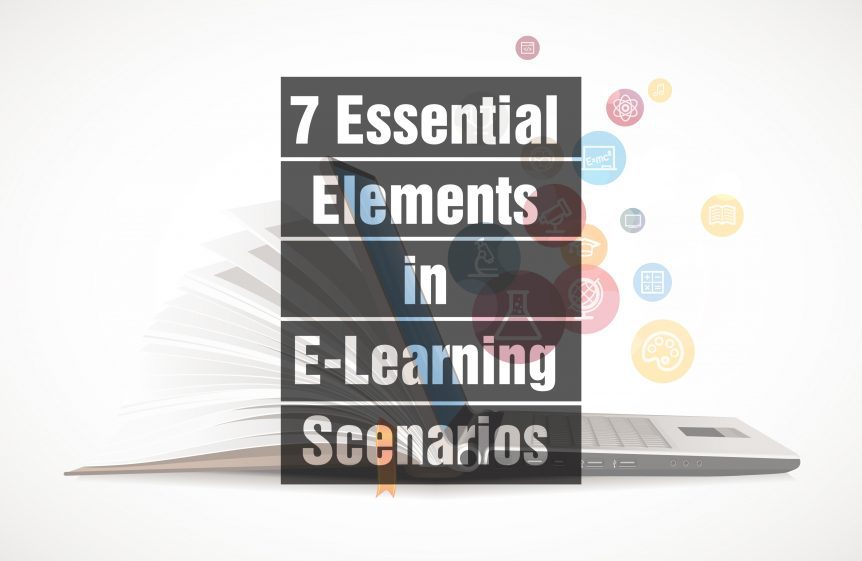7 Essential Elements in E-Learning Scenarios
Scenarios are a powerful tool to use in any e-learning course. They are the digital form of role-playing where learners get to put their new knowledge into action. How do you make scenarios in your e-learning courses as effective as possible? Here are seven essential elements that should be in all e-learning scenarios.
- Good story
- Realistic situation
- Believable characters
- Realistic choices
- Challenging decisions
- Consequences that are realistic
- Focus on learning
Each one of the above elements is as important as the others. Let’s look at each in more detail.
1. Good Story
Scenarios are about engaging learners and helping them learn by doing. To achieve this, however, the scenario must be interesting. This requires building a good story behind the scenario.
You don’t need to go into a lot of detail. In fact, minimal detail is preferable, so long as the story is interesting.
2. Realistic Situation
The story should also have a realistic situation, i.e. something that learners will instantly recognise. The worst thing you can have is the learner switching off because they think the scenario is nothing like the situations they face on a daily basis.
Be careful with this element if you have people from different departments, business units, or levels of seniority doing the same e-learning course. This is because the reality for each of these groups of people will be different.
Some options available to help you overcome this is to make the scenario as job and role-neutral as possible. You can also personalise your e-learning course so there is a different scenario for each group of learners. The differences between each scenario don’t have to be much – just enough so that each learner views it as a realistic situation.
3. Believable Characters
Most scenarios involve characters – a customer, a supplier, a member of staff, a contractor, etc. Just like the previous point, each character should be as believable as possible.
By making the characters believable, your scenarios will be more interesting and engaging. Also, the learning experience will be better as learners will focus on the content of the scenario rather than thinking about flaws in the characters.
4. Realistic Choices
This point carries on the realistic/believable theme. It focuses on the choices you present to learners.
This is important for many of the reasons mentioned in the previous point, particularly that learners will get more from the experience if the choices you present them with match the choices they have faced – or will face – in real life.
Remember, creativity is important when creating scenarios for e-learning courses, but this should never be at the expense of realism or believability
5. Challenging Decisions
Although they sometimes do, scenarios don’t have to have right and wrong answers. They can instead have answers that are better and more effective than others. This keeps the emphasis on using scenarios as a learning tool (see more on this below).
That said, the decisions you ask learners to take should be challenging. This means getting the learner to use the knowledge and skills they have acquired doing the e-learning course in addition to using their own initiative and experience.
Again, this keeps learners engaged, plus they will learn more. In fact, they will learn more even if they get a decision in the scenario wrong or if the decision is not as good as it could be.
6. Consequences That Are Realistic
Going back to the theme of believability and realism, the consequences that happen as a result of the decisions that learners take should be realistic. Exaggerating by making the consequences of decisions too grave or too beneficial does not help the learner.
As with previous points, you don’t want the learner to think “that would never happen”. Instead, the consequences of decisions in scenarios should match the day-to-day experience of learners.
7. Focus on Learning
The entire focus of a scenario in an e-learning course is to facilitate learning. Some people, however, use scenarios as a testing tool. It can do that too, but it is too powerful a learning tool to be used just for testing, particularly when there are other testing options available.
The better approach is to use scenarios for learning. That means not necessarily having right or wrong answers or outcomes. It also involves explaining why a decision is good or bad. In the case of the latter, you should explain where the learner went wrong and how they can improve.
Relatable, Challenging, and All About Learning
The summary is that scenarios in e-learning should be relatable by being realistic and believable. They should also challenge the learner and have teaching elements, both of which improve the presentation of content and the learning experience.
By achieving this, scenario elements in your e-learning courses, and your courses overall, will improve.
